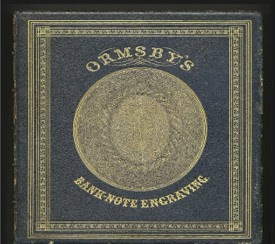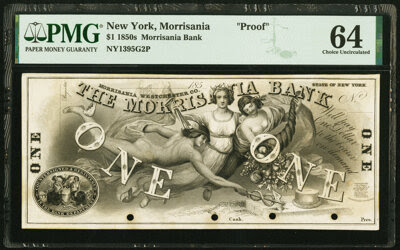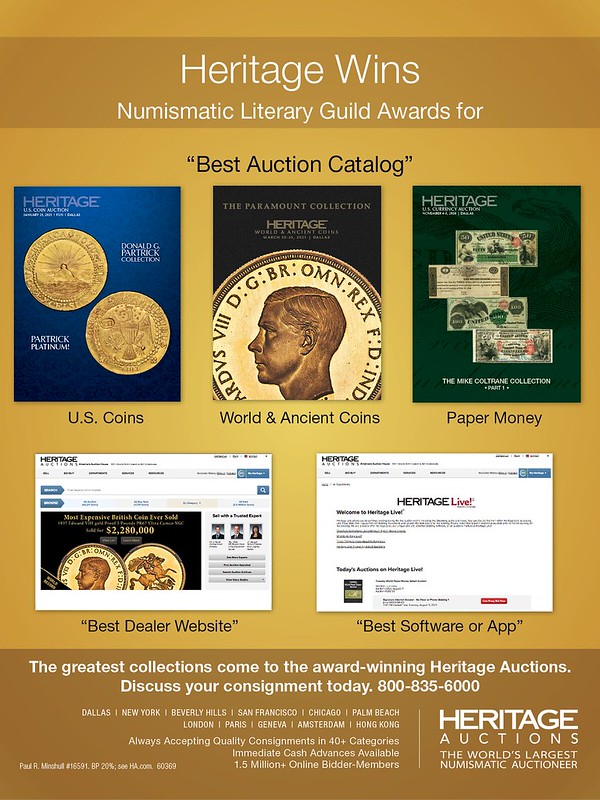
PREV ARTICLE
NEXT ARTICLE
FULL ISSUE
PREV FULL ISSUE
W.L. ORMSBY, PART THREESusan Bremer of Heritage published the last of a series of articles about engraver, author and publisher W.L. Ormsby. It appeared in the September 1, 2021 issue of the Heritage Currency News email. -Editor
A prolific author, Ormsby wrote multiple texts on anti-counterfeiting. His first volume, A Description of the Present System of Banknote Engraving, was published in 1852. This book detailed the many contributing factors that permitted the preponderance of counterfeiting occurring at that time. After the publication of this book, rather than being met with thanks and congratulations, Ormsby, to his own great surprise, became the subject of journalistic criticism and allegations of counterfeiting. The public generally ignored these rumors for a number of years, but that all changed in March 1858. In this final foray into the fascinating legacy of W.L. Ormsby, we will take a deeper look at his writings, and their role in his professional downfall. Part I and II of this series introduced W.L. Ormsby, his inventions, engravings, and some of his writings. All were in service to his passionate interest in banknote engraving and its improvement to deter counterfeiting. Ormsby's dedication to the issue of counterfeiting during the 1850s-60s was unrelenting. His brash writings spurred scandal and contributed to his lasting legacy as an accused counterfeiter. A prolific author, Ormsby wrote multiple texts on anti-counterfeiting. His first volume, A Description of the Present System of Banknote Engraving, was published in 1852. This book detailed the many contributing factors that permitted the preponderance of counterfeiting occurring at that time. After the publication of this book, rather than being met with thanks and congratulations, Ormsby, to his own great surprise, became the subject of journalistic criticism and allegations of counterfeiting. The public generally ignored these rumors for a number of years, but that all changed in March 1858.
Accusations and rumors continued to plague Ormsby. In March 1858, Ormsby filed a suit against Benjamin Douglas, the proprietor of the Merchantile Agency in New York City for public and malicious slander for $10,000 in damages. The case was founded upon Douglas having told a group of New York businessmen that Ormsby would engrave plates for anyone, without thought or question to the client. During the case, Douglas's attorneys asserted that Ormsby had counterfeited notes for eight different banks and engraved labels for fraudulent medical products. However, when pressed, Douglas's attorneys were unable to provide corroborating evidence. Despite this, the judge ruled against Ormsby, stating that the slander was committed privately and therefore was not public or malicious. The judicial decision was upheld during Ormsby's appeal. His final work, Cycloidal Configurations, or the Harvest of Counterfeiters, was published in 1862. Ormsby used a fair portion of this work as a personal diatribe, casting blame on other banknote companies for the rumors and allegations circulating against him: "...when the Banknote Companies saw how the proposed reform would diminish their profits, it became a business to malign me. But, in the ten years struggle that ensued, every Bank Note Company perished or was absorbed in one establishment. Mine alone remained, and I still remain, the sole representative working engraver, at the head of a Bank Note Establishment, in the entire country..." Despite the distraction of this personal digression, Cycloidal Configurations, or the Harvest of Counterfeiters remains important, as it introduced Ormsby's best anti-counterfeiting tool - the Furioso notes, which are single-plate engraved notes. (An example of this type is shown [above]) While potentially an effective counterfeiting deterrent, this idea never gained any traction with US Treasury Department, perhaps due to the time and expense involved, or perhaps simply because it sprang from poorly regarded Mr. Ormsby. Cycloidal Configurations details at length the Treasury Department's many failures both to recognize and support his attempts to help and improve the system as well as to ensure that US banknotes were difficult to counterfeit. Ormsby strongly believed that the patchwork system in use for currency could be easily counterfeited. Salmon P. Chase and Spencer Clark, at the Treasury Department, particularly impacted Ormsby's career. Spencer Clark was designated to design the National Currency, introduced in 1863. He chose to adopt the methods defined in Ormsby's first volume, A Description of the Present System of Banknote Engraving, published 11 years earlier. Salmon P. Chase believed that ideas were Clark's and approved the adoption of these methods as well. Unfortunately, due to Clark's ineffective communication with the banknote companies, the only note that closely follows Ormsby's recommendations is the $5. The other National Currency notes were created in the patchwork system. Secretary Chase refused to let the Continental Bank Note Company have anything to do with National Currency, likely because of Ormsby's public reputation. A letter from Ormsby to Salmon P. Chase in 1867 places the blame for Ormsby's forced retirement and loss of career on Chase's actions. In 1870, a letter from Ormsby to Hon. Geo. S. Boutwell details the use of Ormsby's book by Clark, the Continental Bank Note Company's loss of revenue as consequent to Chase's decision, the company's eventual takeover from co-founder Touro Robertson, and another dogged offer of aid to the Treasury Department. Sadly, yet unsurprisingly, the Treasury Department never gave Ormsby the opportunity to join its forces. Ormsby spent his retirement on a farm in Hampton, Connecticut, initially purchased for his mother. He passed away in 1883 at the age of 74. W.L. Ormsby's unflagging passion for anti-counterfeiting is well documented. He spent most of his years designing more effective anti-counterfeiting tools and fighting to persuade the banking industry and government to use them. Best remembered as an accused counterfeiter, Ormsby's contributions through writing, invention, and engraving brought important advancements to the banknote industry. His life's story is one that few will forget.
To read the earlier E-Sylum article, see:
Wayne Homren, Editor The Numismatic Bibliomania Society is a non-profit organization promoting numismatic literature. See our web site at coinbooks.org. To submit items for publication in The E-Sylum, write to the Editor at this address: whomren@gmail.com To subscribe go to: https://my.binhost.com/lists/listinfo/esylum All Rights Reserved. NBS Home Page Contact the NBS webmaster 
|



